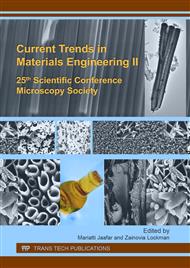[1]
Water Scarcity, United Nation, International Decade for Action Water for Life (2014) 2005–(2015).
Google Scholar
[2]
S. Baruah, R. Kitsomboonloha, M.T.Z. Myint, Nanoparticle applications for environmental control and remediation, in: R.S. Chaughule, R.V. Ramanujan (Eds. ), Nanoparticles: synthesis characterization and applications, American Scientific Publishers, Valencia, California, USA, 2009, p.195.
Google Scholar
[3]
I.A. Salem, M.S. El-Maazawi, Kinetics and mechanism of color removal of methylene blue with hydrogen peroxide catalyzed by some supported alumina surfaces, Chemosphere 41 (2000) 1173–1180.
DOI: 10.1016/s0045-6535(00)00009-6
Google Scholar
[4]
T. Bhuyan, K. Mishra, M. Khanuja, R. Prasad, A. Varma, Biosynthesis of zinc oxide nanoparticles from Azadirachta indica for antibacterial and photocatalytic applications, Materials Science in Semiconductor Processing 32 (2015) 55–61.
DOI: 10.1016/j.mssp.2014.12.053
Google Scholar
[5]
M. Marcucci, I. Ciabatti, A. Matteucci, G. Vernaglione, Membrane technologies applied to textile wastewater treatment, Ann. N. Y. Acad. Sci. 984 (2003) 53–64.
DOI: 10.1111/j.1749-6632.2003.tb05992.x
Google Scholar
[6]
M. Eskandari, N. Haghighi, V. Ahmadi, F. Haghighi, S.R. Mohammadi, Growth and investigation of antifungal properties of ZnO nanorod arrays on the glass, Physica B: Condensed Matter 406(1) (2011) 112–114.
DOI: 10.1016/j.physb.2010.10.035
Google Scholar
[7]
A. Hatamie, A. Khan, M. Golabi, A.P.F. Turner, V. Beni, W.C. Mak, A. Sadollahkhani, H. Alnoor, B. Zargar, S. Bano, O. Nur, M. Willander, Zinc oxide nanostructure-modified textile and its application to biosensing, photocatalysis, and as antibacterial material, Langmuir 31(39) (2015).
DOI: 10.1021/acs.langmuir.5b02341
Google Scholar
[8]
B. Pant, H.R. Pant, N.A.M. Barakat, M. Park, K. Jeon, Y. Choi, H.Y. Kim, Carbon nanofibers decorated with binary semiconductor (TiO2/ZnO) nanocomposites for the effective removal of organic pollutants and the enhancement of antibacterial activities, Ceramics International, 39(6) (2013).
DOI: 10.1016/j.ceramint.2013.02.041
Google Scholar
[9]
M.T. Thein, S.Y. Pung, A. Aziz, M. Itoh, Stacked ZnO nanorods synthesized by solution precipitation method and their photocatalytic activity study, Journal of Sol-Gel Science & Technology 74 (1) (2015) 260-271.
DOI: 10.1007/s10971-015-3646-z
Google Scholar
[10]
Information on https: /www. slideshare. net/joserabelo/crystal-sizeanalysis-14515972.
Google Scholar
[11]
S.Y. Pung, W.P. Lee., A. Aziz, Kinetic study of organic dye degradation using ZnO particles with different morphologies as a photocatalyst, International Journal of Inorganic Chemistry (2012) 1-9.
DOI: 10.1155/2012/608183
Google Scholar


